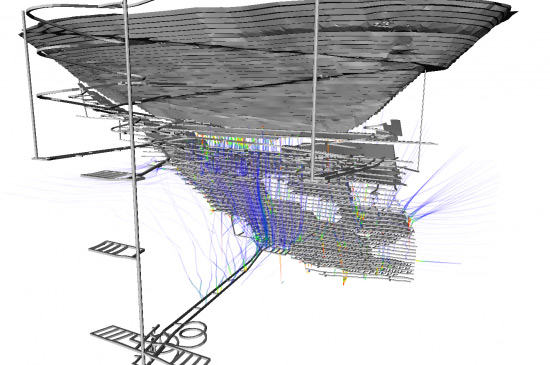Hydro-Mechanical Coupling
The presence of groundwater has an impact on productivity at underground operations. Conventional design approaches focus on either hydrological or mechanical simulations, without acknowledging the inter-connectivity of both problems. To overcome this limitation Beck Engineering developed a framework to efficiently solve transient, hydro-mechanically coupled, discontinuous problems even for large-scale, three dimensional, models with complex geometry and multiple excavation sequences.
In one-way coupling, the pore water pressure field is applied to the mechanical model to determine rockmass behaviour with consideration of pore pressures in the constitutive formulation, according to Terzaghi’s effective stress concept. This results in displacement and damage fields that are different to those obtained by simulating dry conditions. The hydrogeological parameters are assumed to be independent of strain.
One-way coupling is usually sufficient if the pore water pressures are not expected to have a large impact on rockmass behaviour. However, if pore water pressure is driving rockmass behaviour, as is often the case for saturated and partially saturated pit slopes, then two-way coupling is preferable.

Flow-traces in a mine-scale coupled hydro-mechnical discontinuous finite element model
In two-way coupling, the pore water pressure field is applied to determine the rockmass response, including rockmass damage, and in turn damage (and possibly other parameters such as stress and dilation) are then used to calculate updated hydrogeological conductivity for the next model iteration.
Hydro-mechanical coupling can be either implemented in steady state simulations, or can be applied as a full transient simulation.
Our simulations capture the increase in hydraulic conductivity due to the evolution of rock mass damage. They also accurately predict the developing flow paths along discontinuities at different scales. Regional scale discontinuities such as large faults follow the same Darcy constitutives as the bulk material (with different domain properties), whereas small scale discontinuities such as fractures follow a different model theory for flow based on the aperture.
The aperture (parallel plates) theory can be used in synthetic rockmass models to determine the dependency of hydraulic conductivity on rockmass damage for homogenized rockmass at RVE scale.

Very significant damage, as well as a high flow system evolves at the confluence of major fault structures due to fluid influx through the magma chamber at the bottom of the image.
Model features
- Complex geometry and mining sequence:
Accurate simulation of rock behaviour for each geotechnical domain, as well as explicitly built discontinuities allowing realistic slip, separation and damage. - Hydraulic properties of each domain can be
- isotropic, orthotropic, fully anisotropic,
- rock mass damage dependent:
nonlinear increase in permeability with increase in rock mass damage
- Flow along and across discontinuities at different scales.
- Transient or steady-state analyses.
- Fully saturated or partially-saturated or dry rock conditions can be assumed.
- Solution dependent boundary conditions.
We offer
- 15 years of experience in building and running sophisticated geotechnical models for the mining industry
- An international team of mining and rock mechanics engineers with more than 100 years of combined professional experience
- High resolution models with high similitude forecasting of rock mass performance
- Results are presented in a form that is unambiguous and which can be more easily understood
- A simulation framework designed to your specifications and not limited due to implementation constraints
- Full three-dimensional results database available for site engineers to use for ongoing confirmation, analysis and refinement.
- Full transparency: We will assist you how to get the most out of the results, what information would improve the forecasts and work with you to continually improve your mine.

 back
back